Last Updated on June 6, 2025 by Kittredge Cherry
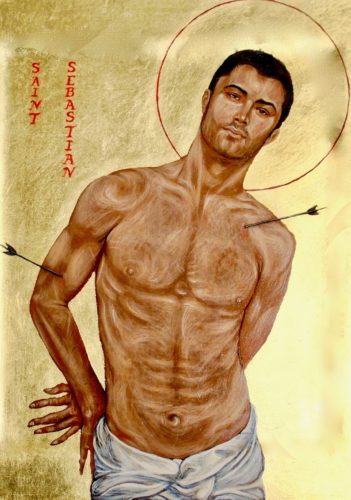
Saint Sebastian has been called history’s first gay icon and the patron saint of homosexuality.
Sebastian was an early Christian martyr killed in 288 in Rome on orders from the Roman emperor Diocletian. His feast day is Jan. 20. He is the subject of countless artworks and religious medals that show him as a near-naked youth writhing as he is shot with arrows. The homoeroticism is obvious.
Nothing is known about Sebastian’s love life, so his long-standing popularity with gay men is partly based on the way he looks and the sheer sensuality of his portrayals. Many also identify with how he suffered with grace when attacked on religious grounds. Sebastian is a recognized as protector against plague, which adds to his appeal for the LGBTQ community during the AIDS pandemic. His iconography affirms what has been called “the sanctity of penetration.”
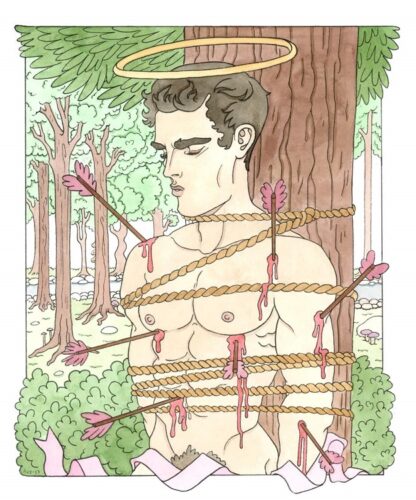
“Saint Sebastian” watercolor painting by Andrew Freshour
The historical Sebastian actually survived the arrow attack and was nursed back to health by Saint Irene of Rome, only to be “martyred twice” when the emperor executed him later. In addition to his longstanding but unofficial status as patron saint of gay men, Sebastian is a patron saint of soldiers, archers and athletes.
Renaissance artists loved to depict Sebastian, and he was portrayed by some of the greatest, including Gian Lorenzo Bernini, Sandro Botticelli, Andrea Mantegna, Perugino, Titian, and El Greco. Artwork of Sebastian’s martyrdom seems to balance two aspects: his beauty or his suffering, sometimes conveying both simultaneously. Sebastian rose to international prominence in the gay literary world of the19th and 20th centuries. His name or image alone became a code for erotic attraction between men.
Saint Sebastian’s martyrdom is legendary
Sebastian was born around 255 in Narbonne in present-day France. Not much is known about his life, and most of it comes from unreliable hagiographies written centuries after his death. The oldest record is the Chronograph of 354, a sort of calendar that lists him as a martyr who was honored on Jan. 20. He probably spoke a local version of French and Latin, the official language of the Roman military. A fourth-century sermon by Saint Ambrose mentions that he came from Milan, Italy, and was already venerated there.
The following details come from the pious legends that arose around Sebastian. He studied in Milan, Italy, and took the unusual step of joining the anti-Christian Roman army even though he was a Christian. His goal was to be a spy and aid other Christians without arousing suspicion. Sebastian was successful in his double life as a both soldier and a Christian. He converted many other soldiers and their families to Christianity while getting promoted to serve in the Praetorian Guard that protected Emperor Diocletian.
But eventually he got caught and Diocletian ordered him to be stripped and killed by being tied to a stake on a training field and used for archery target practice. “And the archers shot at him till he was as full of arrows as an urchin (hedgehog) is full of pricks, and thus left him there for dead,” says “The Golden Legend: Lives of the Saints,” a 13th-century collection of hagiographies. It’s possible that the archers who were forced to shoot him also knew him or even loved him.

Sebastian’s story is told in images like this from the book “Heavenly Homos, Etc.: Queer Icons from LGBTQ Life, Religion, and History” by Jan Haen, a Dutch artist and Roman Catholic priest.
Irene of Rome, later made a saint herself, collected his body for burial — but he was still alive! She nursed him back to health. Other Christians urged him to leave Rome, but instead he did the opposite.
He confronted Diocletian publicly, speaking truth to power by denouncing his unjust persecution of Christians. The surprised Diocletian commanded him to be executed again, and this time they succeeded. Sebastian was beaten to death and his body was thrown in a sewer.
A holy widow named Lucina or Lucy found his body and buried his remains near the catacombs on the Appian Way, where the Basilica of St. Sebastian now stands. The catacombs of St. Sebastian are still open to visitors. His reputation continued to grow over the centuries, especially as a protector from plague during the Middle Ages.
Saint Sebastian in contemporary art: Regan O’Callaghan
A strong, resilient Sebastian has light stubble and a contemporary vibe as he gazes directly at the viewer in an icon by Regan O’Callaghan, an artist/priest of Maori/Irish descent based in London, The icon appears at the top of this post. England. Originally from New Zealand, he moved in 1993 to the United Kingdom, where he studied art and religion, and was ordained by the Church of England.
On his website, he describes how he designed this icon because he wanted to address the erotic and sexuality in faith and spirituality — even though fear and ignorance often prevent such discussion in some religious circles. He wrote:
“It is almost as if some people have let their own hands be tied behind their backs but when they look they see there is no rope! The question is why have some people allowed themselves to be conditioned into thinking the erotic as sinful in all contexts and sexuality as having implicit religious norms? The arrows of condemnation easily hit their intended targets in this situation. Hands are rung in despair and guilt but why? In this icon Saint Sebastian conveys all these emotions and confusions and yet thankfully he is not contained by the boundaries of religious judgement.”
Saint Sebastian in contemporary art: Richard Stott
Richard “Ric” Stott, a gay Methodist minister and artist in Britain, frees Sebastian from standard iconography by presenting him as a proud black man. He portrays Sebastian as Jide Macaulay, a gay Nigerian priest who who set up a church in Nigeria for LGBTQ people under dangerous circumstances and founded House of Rainbow in London.
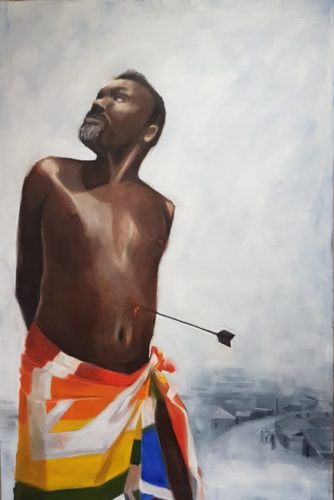
Jide Macaulay as Saint Sebastian by Richard Stott
Stott painted the large canvas in 2019 for an exhibit on migration. He explained the theology behind the painting in an interview at the Black and Minority Ethnic (BAME) Anglican blog:
“St Sebastian is often seen as an iconic gay figure and, in the Western art tradition, as a young white man – painting him in this way seeks to liberate the the idea of St Sebastian from such a narrow lens. In addition, I have painted the figure in such a way as he is pierced and wounded (as is the traditional representation of St Sebastian) and yet still standing proud and strong. This echoes some of the experiences in Jide’s life – he has faced deep and painful opposition, not least because of his sexuality, but still stands beautiful and strong: he is not a victim.”
For more info on Stott, see the previous article “Gay artist paints ‘Intimacy with Christ’: Richard Stott reflects on sensual spirituality.”
Saint Sebastian in contemporary art: Tony O’Connell
Sebastian is a major recurring subject in the work of queer British artist Tony O’Connell. “Sebastian became a subversive object of devotion for lots of queer artists and LGBT people, who are often rejected or abused by religious hierarchies,” he explained.
His art was featured in London’s 2019 group exhibit “Arrows of Desire,” which explored Sebastian’s influence on contemporary artists through themes of religion, sexuality and persecution.
Previously O’Connell sculpted a life-size statue of Sebastian and made a film of his dramatic interactions with the figure to make a strong statement against homophobic violence in a performance art piece for All Saints Day. It includes a “Litany of the Queer Saints” that calls upon Sebastian to pray for and protect the downtrodden:
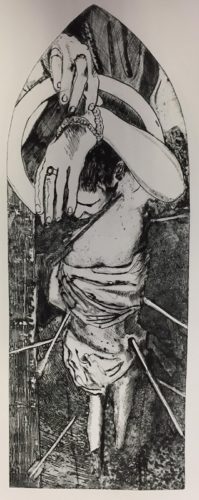
Saint Sebastian etching by Tony O’Connell
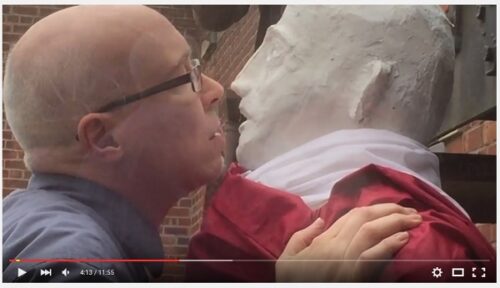
Tony O’Connell prepares to kiss St Sebastian in his film
“St. Sebastian, who strengthens the persecuted Pray for us…
St. Sebastian empowered to protect from plague and AIDS, Pray for us…
St Sebastian, loved and then abandoned by the Roman Emperor, Pray for us.
St. Sebastian, loved and increasingly abandoned by the Roman Church, Pray for us
St. Sebastian, Loved by our people, Pray for us…
Glorious Martyr and undefeated warrior,
we ask that you protect the persecuted
from tyrants and enemies.
Use your unstoppable energy
not to punish but only to humble
those who dedicate themselves to oppression and evil.”
For the whole litany and more info, see my previous post New art film highlights queer saints, Sebastian and homophobic violence for All Saints Day.
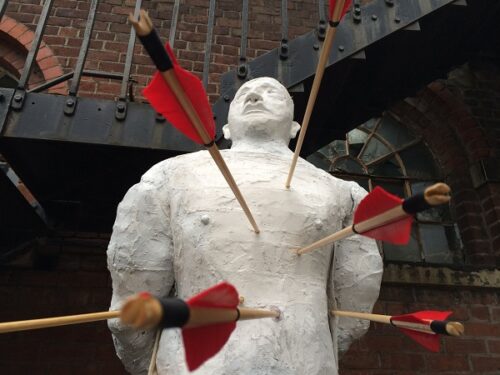
Sebastian is martyred by arrows in O’Connell’s film
Sebastian also appears with a rainbow halo as a “wrathful protector saint” in O’Connell’s “Triptych for the 49,” a tribute to the people killed by a mass shooter at the Pulse gay nightclub in Orlando, Florida.
Sebastian in contemporary art: Andrew Freshour
Sebastian appears with refreshing clarity in a 2020 artwork by Andrew Freshour, a New Hampshire artist and gay Episcopalian. Sebastian’s halo seems to be carved — or maybe burned — into the wood of the tree behind him. Freshour earned a BFA in illustration from the New Hampshire Institute of Art in 2013.
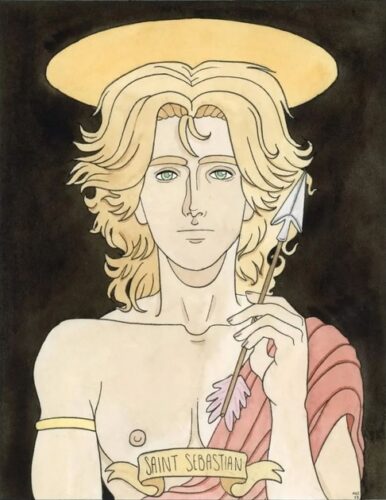
“Saint Sebastian” by Andrew Freshour
Freshour, who has painted Sebastian multiple times, returns to saint with a delicate image in 2024. An uninjured Sebastian gingerly fingers a single arrow, foreshadowing his future martyrdom.
Rare Sebastian painting auctioned
A magnificent, rarely seen 1925 painting of Saint Sebastian by was up for auction through May 24, 2020. Swedish artist Owe Zerge treasured it as his favorite painting.
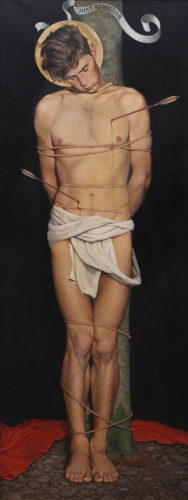
“Saint Sebastian” by Owe Zerge (Garpenhus Auctions)
During his lifetime Zerge refused many offers to sell it, and instead kept the beloved painting hanging in his home until his death in 1983. The model for Sebastian was Hugo Holmer, Zerge’s friend and travelling companion. Zerge did many portraits of young men, including male nudes, as well as landscape and still life paintings. His work hangs in several art museums in Sweden.
The life-size oil painting measures almost six feet tall. On May 24 the auction closed without selling the painting because the reserve price was not met, even though the bid reached $25,800 (23,719 Euros) at Garpenhus Auctions of Sweden.
Sebastian in contemporary art: Sabrina Zarco
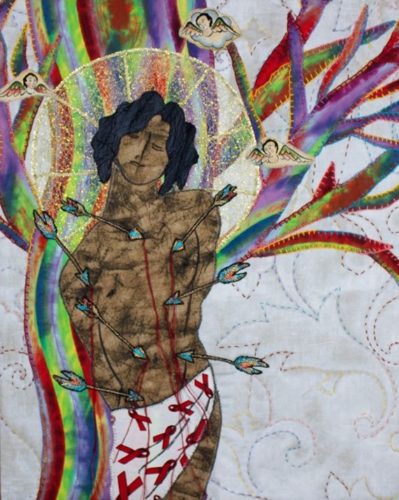
“Arrows of His Desire,” an art quilt by Sabrina Zarco
Chicana autistic artist Sabrina Zarco brings out the queer meanings of Sebastian’s suffering in her 2020 art quilt “Arrows of His Desire.” The red AIDS ribbons on his lioncloth, the arrowheads like pink triangles, and the rainbow quality of the tree all echo contemporary LGBTQ symbolism.
Zarco’s mixed-media fiber artwork was part of “The Adoration of Saint Sebastian,” an exhibition at the Acansa Gallery in North Little Rock, Arkansas. A video gallery tour by curator Will Hogg puts it in context with the other Sebastian art there.
Sebastian in contemporary art: Davidd Batalon
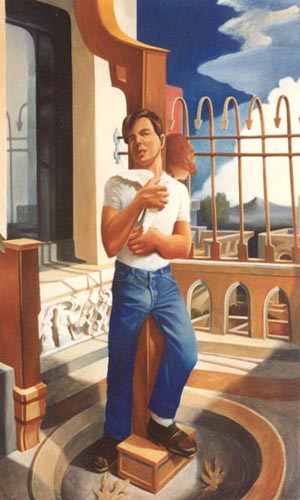
“Bird in the Hand” by Davidd Batalon (Collection of Audrey Lockwood)
In a break with traditional representations of Sebastian, he is deliberately NOT being martyred in a 2000 painting by gay Los Angeles Filipino American artist Davidd Batalon. He bends the “arrows” in the fence downward, representing the survival of gay men during the AIDS pandemic. Batalon returned to the theme in “Sebastian Attraction,” which shows the martyr exhibiting magnetic control over metal objects.
Sebastian in contemporary art: Keith Vaughan
The men who shot the arrows at Sebastian make a rare appearance in “The Martyrdom of St Sebastian” by Keith Vaughan. They also appear to be victims of an unjust system, looking like nude martyrs themselves.
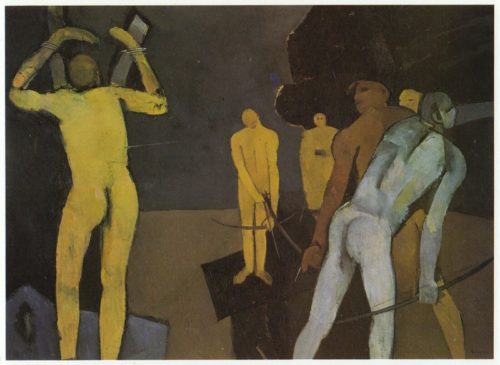
“The Martyrdom of Saint Sebastian” by Keith Vaughan. This print was available from The Picture Shop on eBay.
Keith Vaughan (1912-1977) was a gay British artist who was troubled by his sexual orientation. Vaughan’s artworks are collected by many museums, including the British Museum and the Tate Gallery in London.
Sebastian in contemporary art: Felix d’Eon
Gay Mexican artist Felix d’Eon presents the saint with brown skin and a chunky, sensuous body in “The Martyrdom of Saint Sebastian.” A floral frame adds to the allure.
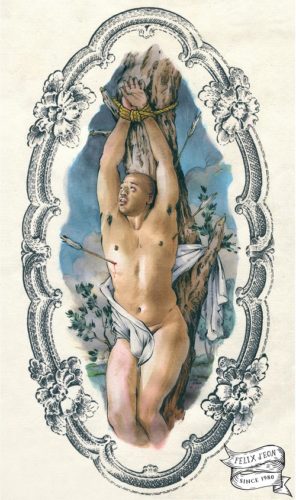
“The Martyrdom of Saint Sebastian” by Felix D’Eon. Prints available on Etsy.
Based in Mexico City, D’Eon describes himself as a “latinx painter and activist dedicated to the art of queer love, romance, and sensuality,” Prints of this and his other art are available at the Art of Felix d’Eon Etsy shop.
Saint Sebastian in contemporary art: More artists
(News alert: A conservative Catholic website accused Q Spirit of promoting “gay porn” because of of the art discussed in this article. More info)
Pink triangles, a gay symbol, surround Sebastian in two new portraits done in the flamboyant Memphis design style by Felix, a Tennessee seminarian and artist who only uses a first name. Nazis used the pink triangle to identify male prisoners sent to concentration camps for homosexuality, and the gay-rights movement reclaimed it in the 1970s and ‘80s. Memphis style is a post-modern style with bright colors, bold patterns, scattered shapes and clashing geometric patterns that blend 1950s kitsch, Art Deco, and Pop Art. It was pioneered in the 1980s by Memphis Group, an anti-establishment design and architecture collective in Milan, Italy. This retro style is currently making a comeback.
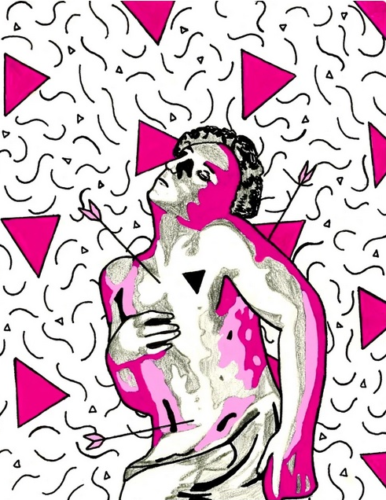
Sebastian by Felix
In one of the new images, Sebastian languishes against a backdrop of pink triangles and squiggly lines. His chest is marked with a black triangle, which was imposed by the Nazis on those condemned as “anti-social,” including lesbians.
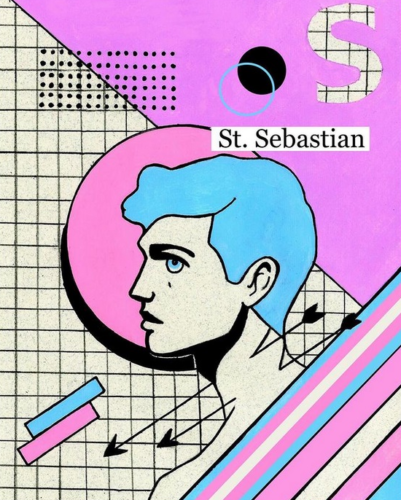
“Memphis Style Saint Sebastian” by Felix
In the other new image, the triangles — and the whole color scheme — are pink and blue in keeping with the colors of the transgender flag. Only Sebastian’s head is visible, with blue hair and a pink halo above the arrows that pierce his neck. Art by Felix is available on Instagram at @felix_sacred_art and on Etsy at the FelixSacredArt shop.
“Saint Sebastian” by Matthew of Queer Catholic Icons
A rainbow loincloth emphasizes Sebastian’s connection with the LGBTQ community in a 2023 icon by Matthew, a practicing Roman Catholic who shares his artwork on Instagram as @queer.catholic.icons. The rainbow colors stand out strong against the monochrome martyrdom image.
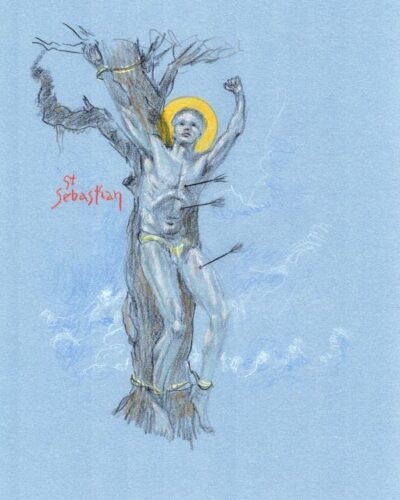
“St. Sebastian” by Tobias Haller
Sebastian shows defiance by raising a fist in an icon by Tobias Haller, an iconographer, author, composer, and retired vicar of Saint James Episcopal Church in the Bronx, still assisting at a parish in Baltimore, Maryland. Haller enjoys expanding the diversity of icons available by creating icons of LGBTQ people and other progressive holy figures as well as traditional saints.
Saint Sebastian is a favorite subject of many contemporary gay artists, including Tony De Carlo (1956-2014). He began his Sebastian series in the 1980s in response to the AIDS crisis and continued it for the rest of this life. It grew to more than 40 pictures before his death.
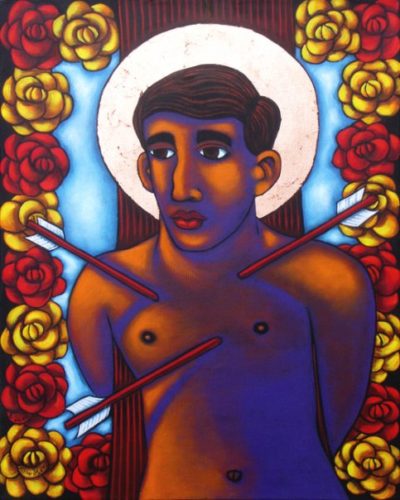
“Homage to Sebastian” by Tony De Carlo
“I chose him because he was known as the Patron Protector Saint Against the Plague, as the Plague was sweeping Europe,” De Carlo said in an interview with the Jesus in Love Blog. “It wasn’t until the year 2001 when I went into a Catholic store in New Mexico, picked up a pewter statue of Saint Sebastian, and saw a label on the bottom that said ‘Patron Saint of Homosexuals.’”
“Saint Sebastian and Matt Shepard Juxtaposed” by JR Leveroni compares Sebastian’s martyrdom with the killing of a contemporary gay martyr, Matthew Shepard (1976-1998). Shepard was a student at the University of Wyoming when he was brutally beaten and left to die by two men who later claimed that they were driven temporarily insane by “gay panic.” His murder led to broadening the US hate-crimes law to cover violence based on sexual orientation and gender identity.
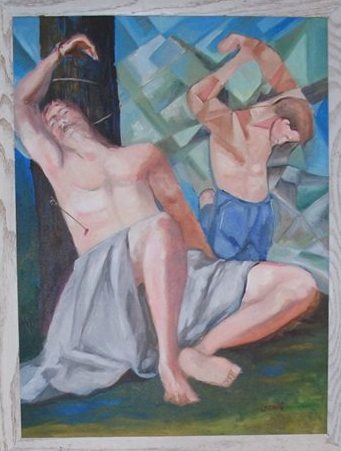
“Saint Sebastian and Matt Shepard Juxtaposed” by JR Leveroni
Leveroni is an emerging visual artist living in South Florida. Painting in a Cubist style, he portrays the suffering gay martyrs in a subdued way with barely a trace of blood.
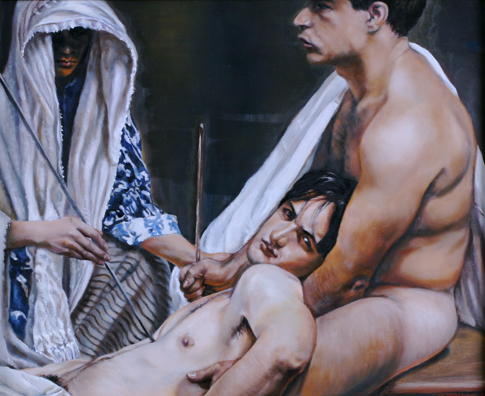
“Saint Sebastian No. 1” by Oscar Magnan
A tender image of the fallen Sebastian between a male companion and Saint Irene was painted by Oscar Magnan. He has an international background and many years as a full professor of fine arts at Saint Peter’s University, a Jesuit institution in Jersey City, New Jersey.
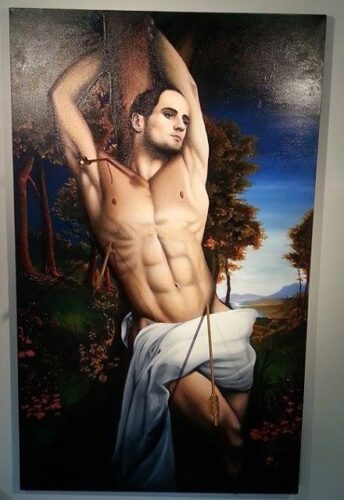
“Self Portrait as Saint Sebastian” by Christopher Olwage
Gay New Zealand artist Christopher Olwage painted a self-portrait as Sebastian for his “Ecce Homo” exhibit inviting viewers to consider the possibility of a gay Jesus.
California gay artist Rick Herold places Saint Sebastian against a colorful, cartoon-like backdrop reminiscent of gay artist / activist Keith Haring, a gay artist who showed Saint Sebastian in his later work. “I over the years as a painter have been interested in the idea of the spirit and the flesh as one — began by Tantric art influences and then using my Catholic background,” he told the Jesus in Love Blog. He paints with enamel on the reverse side of clear plexiglas.
Herold has a bachelor of arts degree in art and theology from the Benedictine Monastic University of St. John in Minnesota and a master of fine arts degree from Otis Institute of Art in Los Angeles. His religious artwork included a Stations of the Cross commissioned by Bob Hope for a church in Ohio before a conflict over modern art with the Los Angeles cardinal led to disillusionment with the church. Herold came out as gay and turned to painting male nudes and homoerotica.
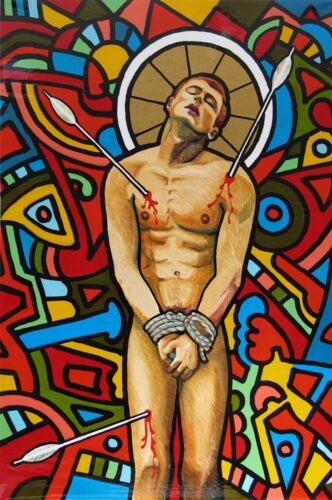
“Saint Sebastian” by Rick Herold
Haring himself created a stunning modern image of Saint Sebastian. It can be seen at the Haring Foundation website (warning: nudity): https://www.haring.com/!/art-work/84. As a gay Pop artist and activist, Haring addressed homosexuality and AIDS in his artwork. He emerged from the graffiti subculture of New York City and died of AIDS-related complications on Feb. 16, 1990.
Gay Mexican artist Nahum B. Zenil shows two nude men, apparently himself and Sebastian bristling with arrows, riding double on horseback as they race away in “The Escape.” His work often explores race, religion and homosexuality.
 An important film biography for many gay men today is “Sebastiane,” directed by British independent filmmaker Derek Jarman. The Latin-language 1976 film was controversial for its homoeroticism and is considered a landmark of LGBTQ cinema. Jarman portrays Sebastian as a Christ figure, connects Christianity with pagan nature worship, and imagines Sebastian in a remote garrison.
An important film biography for many gay men today is “Sebastiane,” directed by British independent filmmaker Derek Jarman. The Latin-language 1976 film was controversial for its homoeroticism and is considered a landmark of LGBTQ cinema. Jarman portrays Sebastian as a Christ figure, connects Christianity with pagan nature worship, and imagines Sebastian in a remote garrison.
A moment of sexual awakening is given visual form in “Peter Hujar Dreaming” by gay artist David Wojnarowicz. In a complex case of art imitating art, the sexually explicit image shows his mentor dreaming of Mishima and Sebastian. Both Wojnarowicz and Haring eventually died of AIDS, and stimatized the disease may have informed their portrayal of the martyred Sebastian.
British artist and self-described “dandy” Sebastian Horsley gave an insightful video tour of an exhibit of Saint Sebastian paintings Reni at the Dulwich Picture Gallery in London.
Saint Sebastian in historical art
Other blogs have already compiled the Saint Sebastian masterpieces from art history since the Renaissance, so Q Spirit refers readers to the many online collections of Sebastian art, such as:
Saint Sebastian (Counterlight’s Peculiars)
Saint Sebastian: The Homoerotic Patron of Gay Men (Artwork I Love Blog)
The Martyrdom Of Saint Sebastian, In Ascending Order Of Sexiness And Descending Order Of Actual Martyring (The Toast)
And some rope – Saint Sebastian (Gods and Foolish Grandeur)
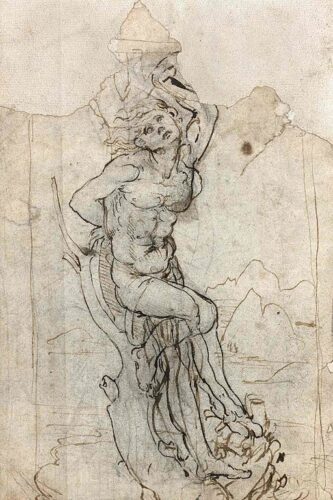
“The Martyrdom of Saint Sebastian” is a drawing by Leonardo Da Vinci that was rediscovered in 2016. A sculpture of Sebastian by another artist was in Da Vinci’s home, Clos-Luce, in central France. (Wikipedia)
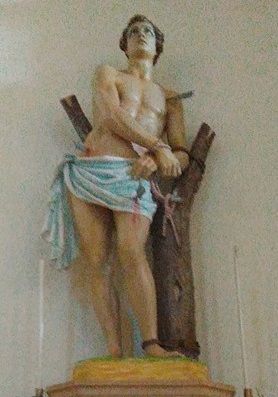
Saint Sebastian statue at St. Anthony’s Church in Macau. Photo by Dave Hall.
Francis and Sebastian meet in Renaissance art
Some Italian Renaissance artists paired Francis with another saint revered by today’s LGBTQ community: third-century martyr Sebastian. To 21st-century eyes, it is a wonderful surprise to see gender-nonconformist Francis next to Sebastian, patron saint of homosexuality. Even though they lived about a thousand years apart, they meet in the mystical space of a genre known as “sacra conversazione” (sacred conversation). What is the man who liked to be called Lady Poverty thinking as he exchanges glances with the near-naked martyr?
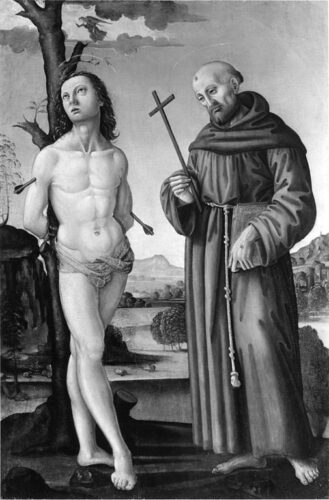
“Saint Sebastian and Saint Francis of Assisi” by Lorenzo di Credi, 1500-1510. (Wikipedia)
Art historians don’t seem to speculate on why Renaissance artists matched two of the most popular queer saints from different centuries, except to say that donors usually chose the saints in such paintings. A possible queer clue comes from the snail near Francis’ foot in a painting of them by Carlo Crivelli. Snails were thought to symbolize the virgin birth because of their asexual / hermaphroditic methods of reproduction.
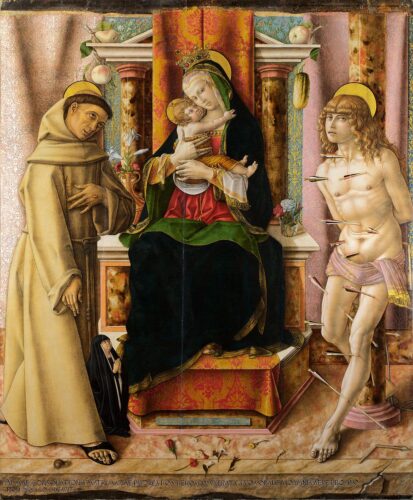
“The Virgin and Child with Saints Francis and Sebastian” by Carlo Crivelli, 1491. (Wikipedia)
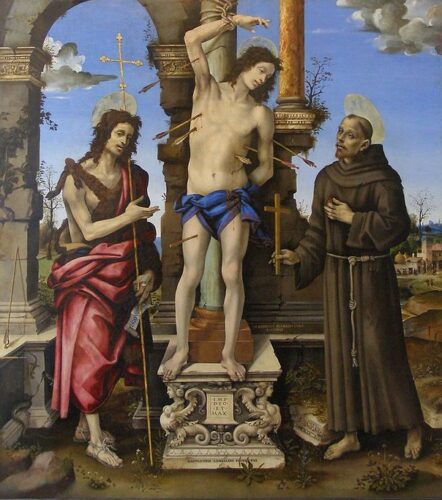
“Saint Sebastian between Saints John the Baptist and Francis” by Filippino Lippi, 1502. (Wikipedia)
Saint Sebastian festivals around the world
The feast of Saint Sebastian or San Sebastián continues to be celebrated with lively festivals around the world, including in Italy, Mexico, Peru and Puerto Rico.
For example, queer and trans people participate in ritual cross-dressing every Jan. 20 at the Tunantada festival honoring patron saints Sebastian and Fabian in Jauja, Peru. This Andean festival is explored in “Cuir Devotion,” a storytelling ethnography performance in which Enzo Vasquez Toral performs as the fictional Andean-inspired drag queen Penelope Sumac. Originally from Peru, Toral is a PhD student at Northwestern University. He has MA degrees from Northwestern and Princeton universities, and a bachelor’s degree from Harvard. “Cuir Devotion” has been presented at a variety of venues and was the keynote event at the Conference on Queer and Transgender Studies in Religion on Feb. 21, 2020, at the University of California Riverside.
Saint Sebastian in literature and music
British gay literary celebrity Oscar Wilde wrote with admiration about Italian Baroque artist Guido Reni’s famous painting of Sebastian and identified so much with the saint that used the name “Sebastian Melmoth” as his own alias after his release from prison for homosexuality.
In his autobiographical novel “Confessions of a Mask,” Japanese author Yukio Mishima writes about becoming aware of his homosexuality. It happened when he was aroused by seeing Reni’s painting of Sebastian in one of his father’s art books. German novelist Thomas Mann, who struggled privately with homosexuality, hailed his beauty in his classic novella “Death in Venice” and praised his “grace in suffering” as he declared Sebastian to be his favorite saint in his acceptance speech for the Nobel Prize for Literature in 1929. American playwright Tennessee Williams named his martyred gay character Sebastian in “Suddenly, Last Summer.”
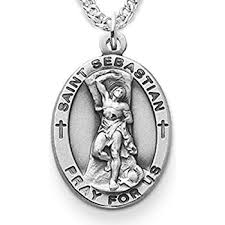
Saint Sebastian appears as a near-naked youth on religious medals
In an open acknowledgement of Sebastian’s gender ambiguity, a woman (celebrated Russian dancer Ida Rubenstein) played Sebastian in the 1911 premiere of a musical mystery play by French composer Claude Debussy. The gender change, in addition to her Jewish faith, scandalized audiences and provoked condemnation by the archbishop of Paris.
Saint Sebastian in poetry
Saint Sebastian is explored in not one, but three poems by Jim Wise. He describes himself as “Queer Poet, Hermetic Mendicant, and Pantheist, itinerant theologist and roving Chaote – an Earth-centered, Eros-loving, Logos-chasing, dirt-worshiping revolutionary – living in the American Midwest.”
He considers himself “something of a UCC Old Catholic spiritual pilgrim” because he attended seminary under sponsorship of the United Church of Christ and was ordained in an Old Catholic jurisdiction. The following poem comes from his “Queer Psalter” collection, currently a work in progress.
Wise’s poetry has appeared in RFD Journal, The Gay and Lesbian Review Worldwide, and a host of online literary journals and zines.
Queer Patron Saint
By Jim Wise
Saint Sebastian,
patron saint of Queers
for no other reason than
we claim you,
and we claim you because
we know what it is to be pierced,
both by love and by hate.
We have felt the ecstasy
of the love’s golden arrows
and we have felt the savage hate
of the iron arrows of vicious empires,
both sacred and profane.
Saint Sebastian,
we offer you our prayers
and all our holy and fleshly desires.
We lay at your blood-stained
feet all the shame that we have
failed to burn in the throes of passion.
Saint Sebastian,
pray for us,
that we may survive
the sharp arrows of hate
they fire into our lives.

Saint Sebastian and Archangel Michael, both known as protectors of gay men, stand together with muscular bare chests in a DaVinci-style print on parchment from Fran Duncan on Etsy.
The Martyrdom of Saint Sebastian
By Jim Wise
Look at paintings of the saint.
The face never seems to reflect
the tormenting pain of the
arrow’s rape.
Instead, a blank expression,
a numbness, a reconciliation
with the truth that pain is
inevitable and inescapable.
Or a look of ecstasy,
as if the body craves both
the piercing and the pain.
No wonder this malleable saint
is the patron of queer men,
who have learned to hide
their pain behind a mask
of apathy, and who know
the ecstasy of piercing
and of being pierced.

Saint Sebastian prayer card from the Avery and Company Etsy shop.
Saint Sebastian
By Jim Wise
It’s easy to forget
how radical those
early believers were.
They stopped looking
for an invisible God
up in the sky and found
him in a person instead.
No wonder they were
hunted down and killed.
After all, God must remain
in Heaven and out of
our business and leave
the running of the world
to his appointed priests.
Right?
Even though they
hate us for the
heretics we are,
I think Queers know
the meaning of Christ
better than anyone.
After all, we stopped
bowing down and looking
up a long time ago.
We have been worshiping
God in the the bodies of
people our whole tribal life.
Strangers, friends, partners,
God is in the flesh of
all our lovers and our
devotion has been pure.
But
if you find God
in the bodies of
human beings
instead of up in
the sky where
a God belongs,
if you worship God
by worshipping the
life-stained skin of
those human beings,
if your Eucharist leaves
the taste of salt and
sweat instead of bland
bread on your tongue,
if your devotion to God
is best done away from
the pomp of temple crowds,
you’re likely to find yourself
on the wrong side of an
angry religious mob,
shot full of arrows and
loved only by God.
Saint Sebastian prayers
Q Spirit’s Litany of Queer Saints includes these lines:
Saint Sebastian, faithful even when stripped naked and pierced by arrows, pray for us.
Canadian gay theologian Donald Boisvert wrote a prayer to Sebastian and other early-church martyrs from an LGBTQ-liberation perspective. This prayer is included in his 2004 book “Sanctity and Male Desire: A Gay Reading of Saints”:
Blessed Saints Sebastian and Tarcisius and you other martyrs of the early church, pray for us. You who challenged and resisted the claims of mundane human power, stand by us. Our eyes are fixed on your beauty. Give us courage and fortitude. Enfold us in your nakedness. Soak us in your redemptive blood. As we stand before the cruel Caesars of this era, may we turn to you for strength and eloquence. And may your deeds be part of the stories of our lives. Amen.
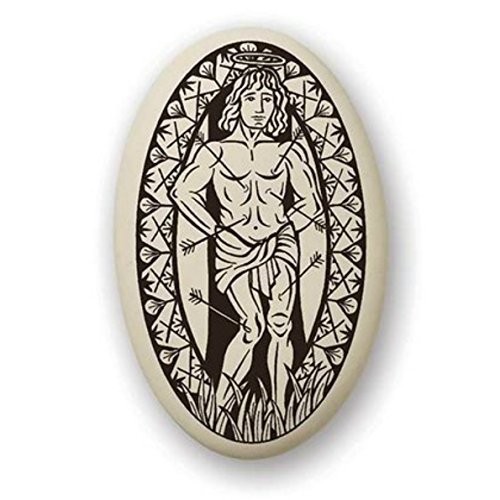
A starkly simplified Saint Sebastian looks like a German expressionist woodcut in a porcelain oval medal (Amazon.com)
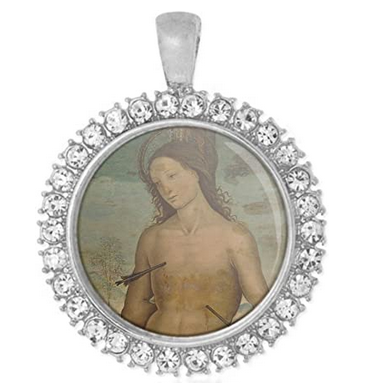
Saint Sebastian appears on a “dainty medal surrounded with rhinestones” — not a common style for saint medallions. It’s available from Realig on Amazon.
Links related to Sebastian as a gay saint
How Saint Sebastian became an LGBTQ icon (Outreach.faith)
The Allure of St. Sebastian (Wild Reed)
Not Dead Yet: St Sebastian as Role Model (Queering the Church)
“Saint Sebastian in South Carolina” by Ed Madden (Gay and Lesbian Review Worldwide)
James Fenton on the lure of Saint Sebastian (Guardian)
“Why is Saint Sebastian a Gay Icon?” (dailyartmagazine.com)
___
To read this post in Spanish, go to:
San Sebastián: Historia de icono gay primero (Santos Queer)
___
Top image credit:
“Saint Sebastian” by Regan O’Callaghan.
___
This post is part of the LGBTQ Saints series by Kittredge Cherry. Traditional and alternative saints, people in the Bible, LGBTQ martyrs, authors, theologians, religious leaders, artists, deities and other figures of special interest to lesbian, gay, bisexual and transgender and queer (LGBTQ) people and our allies are covered.
The first version of this article was posted in January 2013. It was published on Q Spirit in January 2017, was expanded with new material over time, and was most recently updated on June 6. 2025.
Copyright © Kittredge Cherry. All rights reserved.
Qspirit.net presents the Jesus in Love Blog on LGBTQ spirituality.

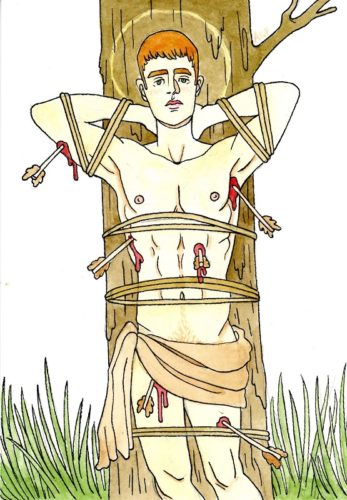



















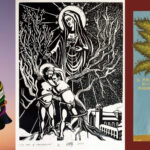

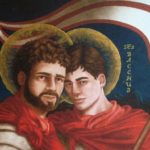
Years before the QSpirit (or even Jesus in Love) blog existed, I painted an icon of this saint and other un-named martyrs. I made my own mental connections with the “gay angle”…it is a Jungian archetype, I believe.
Well, it seems to me some reasons why the IMAGES of Sebastian are popular with gay men might include the following:
(1) The IMAGES of Sebastian usually depict a beautiful athletic nearly naked young man who is
(2) in submissive bondage (so is NOT the image of the dominant-male heterosexual posture — but of a role homosexual men often enjoy playing); and (as if to confirm)
(3) he appears to be not suffering, and perhaps even enjoying the bondage as well as
(4) being pierced (penetrated) by more than one arrow — the Arrow being both a phallic Symbol or Archetype, and the Sign of Eros or Cupid, the Greek or Roman male god of sexual love; and
(5) also appearing to not be suffering excruciating pain, but yet having an intense passionate experience of a different — if not psycho-sexual — nature in response to being penetrated (similar to Michelangelo’s sculpture of St. Teresa being pierced by the arrow of an angel who looks very much like Eros/Cupid — no doubt drawing upon the sculpture’s own experience of being “pierced”, as well as the saint’s own ecstasy); and
(6) in light of the notion that being pierced by more than one of Cupid’s arrows at the same time can symbolize being smitten by love and/or lust for more than one person at the same time — or having sex with more than one male at the same time (depending on the number of arrows shown in the IMAGE). These are situations quite common in gay male experience — including that of the one exquisitely beautiful young man who becomes the altar or target upon whom all the others shoot their sacred loads, their arrows. While multiple partners and group sex is universal regardless of sexual orientation — it’s also true that male (and female) homosexuality, even now with marriage equality, remains a bastion of non-monogamy in many forms. In Western culture — the culture that continues to produce Sebastian IMAGES, one may have more than one sexual partner or lover, but not more than one spouse. Final thoughts:
(7) This is clearly about the IMAGE of Sebastian — the icon, even the idol — not necessarily “the historical Sebastian” — similar to the devotion to Christ is often to the IMAGE of Christ, not to “the historical Jesus.” So whether Sebastian — or Jesus — engaged in homosexuality is almost beside the point — we love their IMAGES all the same! And IMAGES — Symbols and Archetypes — have their own powerful reality — as spiritual-psychologists like C. G. Jung have pointed out to us. And, last but not least,
(8) It is also perhaps not a coincidence that one of the singers of male-male love was the German anarchist poet/novelist John Henry Mackay (1864-1933) who wrote in praise of “the Nameless Love” under the pseudonym of “Sagitta”, which in Latin means “Arrow”.
Thank you for your in-depth analysis of Sebastian’s symbolic meanings for the LGBTQ community. You gave me a lot to consider. I would add that have been symbols of the plague at least since medieval times.
Keith Haring’s picture of Saint Sebastian merits inclusion in this lovely collection
https://www.haring.com/!/art-work/84
Thank you for alerting me to Keith Haring’s stunning painting of Saint Sebastian! I will add the link to my article. It is notoriously difficult to get permission to share an actual Keith Haring image. The Haring Foundation just rejected our request for a different gay-saints project, so readers will have to click the link to their website to see his St. Sebastian.
Dear Kittredge
Thank you for this glorious posting. St Sebastian is one of my favorite gay saints. Here is my contribution to literature re Sebastian. Published in my book THE FOUNTAIN (North Carolina Wesleyan College Press, 1992), and also included in my book THE NEW BEAUTIFUL TENDONS: COLLECTED QUEER POEMS 1969-2012 (Spuyten Duyvil/Triton, 2012), which I think you have a copy of. Love and blessings to you and all. Jeffery (my mentor poet/publisher Jonathan Wms always called me Miss S(Tick).
SEBASTIAN AT SIEGE
Mother, the air is a thief.
It steals salt from the body, loosens
the Will, until it splays out, liquid.
I sit straight up in bed, naked,
looking in the mirror. This, my body,
which I consume. The tendons
and frets on which it hangs.
Hating it once, it is now so beautiful, dying
in its time. Learning how to learn, to whistle
with the starlings, names a tender absolution.
In this Byzantine chamber, the air
makes a fist. An angel
bursting through the chalice of the flesh.
In these catacombs I perfect my sweat.
Thank you for sharing your Sebastian poem from “The New Beautiful Tendons.” Indeed I am the proud owner of a copy of your sinewy, sensuous poetry collection.
Thank you Kittredge. I have a new book out which I intend to send you before the summer is out.
Is your new book “Verdant”? I look forward to reading it! The description makes it sound fabulous: “Reminiscent of Eastern Bhakti love poetry, and Western Troubadour and Green Man traditions… queer poet Jeffery Beam fell in love with a younger man… The poet-lover’s sacred quest… progresses ultimately to a joyful ecstatic reunion with the Beloved Divine.” I added this to the “recently released” section of the 2022 Q Spirit list of LGBTQ spirituality books. I plan to will write more about it in the future after I have access to the whole book.
Yes. New book. Verdant. I will try to get it in the mail to you before I leave for France on April 24. Thank you for mentioning it now, and then. All love. Jeffery
Since I can’t reply directly to Tony’s response (no reply button) I’ll have to write a new comment. Firstly, you said you don’t find “torturing naked men with arrows” to be homoerotic but nonetheless find images of St. Sebastian being tortured to death with multiple arrows (while wearing a loincloth) to be homoerotic (which in fact was the main point of the article itself too), so what exactly is it about the image that is homoerotic then? Secondly, you implied that I’m just upset by any suggestion that St. Sebastian was homosexual, but my point was that there is admittedly no evidence for that, and statistically it is certainly far from the norm even if the “1 in 6” or “1 in 10” figure was accurate which it apparently is not, for two reasons: it includes all variations aside from heterosexuality (hence not just homosexuality), and those estimates come from the Kinsey study (if I’m not mistaken) which has been debunked because the study didn’t make any effort to sample a representative cross-section of the population. Kinsey interviewed people who were mostly convicted sex offenders at a time when same-sex intercourse was illegal and of course so were a number of other variations outside the norm, hence the various sexualities of these inmates would not represent the general population. Bottom line: the odds of St. Sebastian having a homosexual orientation would be statistically rather small, and (more to the point) I wouldn’t support any form of speculation about any of his (or anyone else’s) characteristics of any kind since that’s not how history is supposed to be studied. You can’t just make things up.
You admit that “little is known about Sebastian’s love life” (in fact, nothing is known), hence the only link to homosexuality is the fact that gay men enjoy looking at a half-naked young man being penetrated by arrows, which you think is “homoerotic” but in fact is simply the manner in which the Romans tried to kill him.
CGesange, I find your comment fascinating so I’d like to answer it if you don’t mind.
Firstly- Kittredge doesn’t “admit” that little is known about Sebastian’s love life- rather she states it, clearly, as the initial basis for the article. To “admit” implies fault or guilt, (clearly that’s not true) so I’m not sure why you choose language which could be seen as pejorative.
Secondly, this is not an article about Sebastian’s own sexuality but why queer people find him a valuable spiritual archetype. There are many reasons why I personally do.
Thirdly, she is right in stating that little is known about his love life- so I wonder, by commenting in the way you have, are you positing the stance that he was certainly straight? (- which since “little is known” is a difficult thing to evidence other than by simple assumption).
Even by basic initial sexual research in the 20th century between 1 in 10 to 1 in 6 identified somewhere on the spectrum of sexuality other than heterosexual. (Of course that means that at least ten percent of those figures regarded now as saints were, in their human lives, queer in some way. You could even ask of the 12 apostles what was the statistical likelihood there- but that’s a separate issue, let’s stick to Sebastian)
Fourthly – there is an undeniable history of gay artists identifying with Sebastian and that homoeroticisng an image of a Saint is far more about spiritual metaphor than you seem to recognise. The example is given in the article about how this may echo Tantra (a recognised vehicle for spiritual practice for instance in both Hinduism and Buddhism) but, in opposite equivalence to this layering of the erotic and the spiritual, I offer the overwhelming majority of the heteronormative Western art cannon for centuries -which thinks nothing of objectifying and eroticising female subjects for a supposedly male viewer. (This concept is described simply as “the male gaze” by feminist critics. )
Fifthly, as a queer man I can tell you that I find several aspects of maleness erotic -but torturing naked men with arrows has never actually been one of them- (so I find that line in your comment kind of hilarious). Clearly – Kittredge herself doesn’t find this idea homoerotic either but is simply pointing out that images have been explored by artists and poets. This is the use of metaphor and the article explains many reasons for this.
Finally, since for me, this article is exploring the idea that queer people identify with this saint’s image, do you feel that that is somehow problematic?
Surely everyone of us seeks to make sense of the spiritual world in the context of how it relates to our own lives and how we see ourselves reflected in it? Should queer people not identify with sacred archetypal images the way straight people are allowed to do?
Thank you, Tony, for your long and wonderful blog comment on Sebastian in response to “CGesange.” You put into writing much of what I was thinking.
WELL LOST OF THE SAINTS WERE GAY BUT THE CHURCH COVERED IT ALL UP STILL TO .
St Sebastian was not gay. there is nothing historically linking him to homosexuality. simply painting a saint half naked and in a homoerotic pose does not mean a thing. St Sergio and Baccus, on the other hand, were most likely gay and they should be the patron saints of gay people.
In the middle ages and renaissance he was considered the patron saint of gay me. Leonardo de Vinci had a statue of Sebastian in his home where he retired which can still be seen today.
I just adore art, especially, the extraordinary contemporary.Works by Sebastian are the real masterpieces, for sue. Thanks.
Mili Rose, Jersey City, NJ
The non-fatal martyrdom of being penetrated by multiple arrows is sometimes considered an allegory for being sexually abused.
Dear Kittredge,
In my painting, St. Sebastian is with a male and a female companions. She is supposed to be St. Irene.
Thank you
Oscar
Thanks, Oscar! I corrected the description of your painting in my article. Your painting makes more sense to me know that I know Saint Irene is in it.
No sir, I immediately saw that that is the Angel of Death on the left, trying to wrest the dying saint from the arms of the male companion.
That was an interesting read and the paintings are beautiful. It’s an eyeopener for people who use religion as an excuse for hatred. The prayer you’ve mentioned is more relevant today than ever.